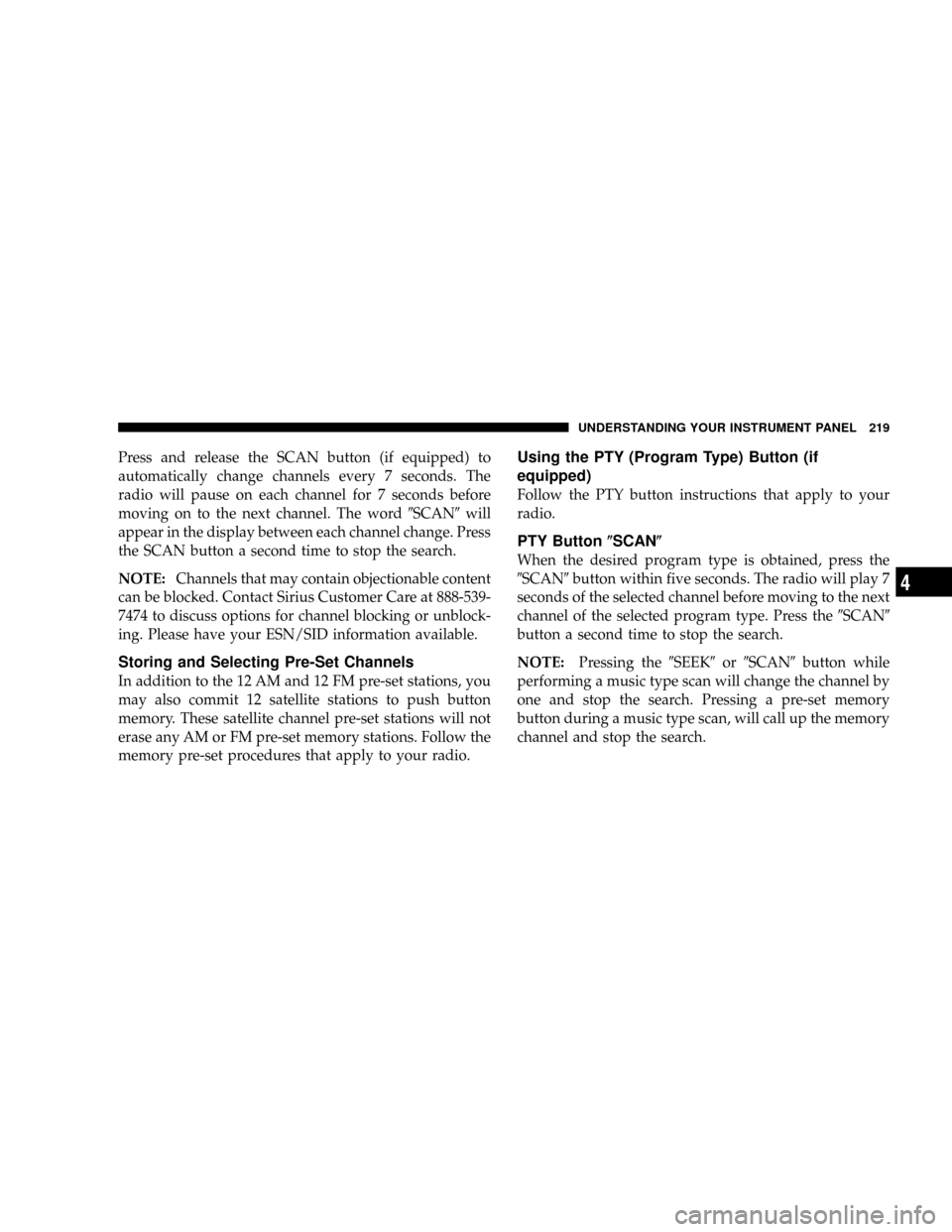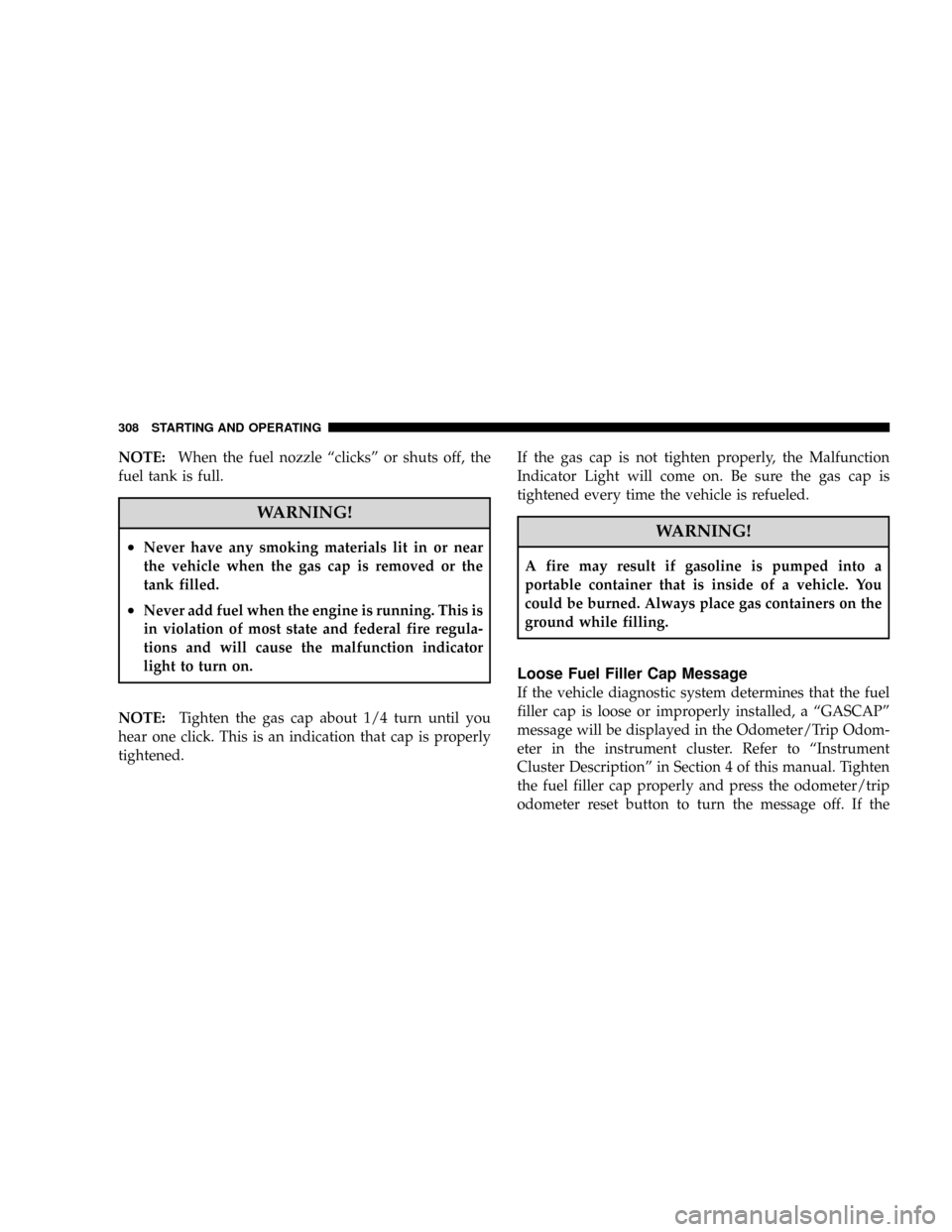Page 220 of 440

Press and release the SCAN button (if equipped) to
automatically change channels every 7 seconds. The
radio will pause on each channel for 7 seconds before
moving on to the next channel. The word9SCAN9will
appear in the display between each channel change. Press
the SCAN button a second time to stop the search.
NOTE:Channels that may contain objectionable content
can be blocked. Contact Sirius Customer Care at 888-539-
7474 to discuss options for channel blocking or unblock-
ing. Please have your ESN/SID information available.
Storing and Selecting Pre-Set Channels
In addition to the 12 AM and 12 FM pre-set stations, you
may also commit 12 satellite stations to push button
memory. These satellite channel pre-set stations will not
erase any AM or FM pre-set memory stations. Follow the
memory pre-set procedures that apply to your radio.
Using the PTY (Program Type) Button (if
equipped)
Follow the PTY button instructions that apply to your
radio.
PTY Button(SCAN(
When the desired program type is obtained, press the
9SCAN9button within five seconds. The radio will play 7
seconds of the selected channel before moving to the next
channel of the selected program type. Press the9SCAN9
button a second time to stop the search.
NOTE:Pressing the9SEEK9or9SCAN9button while
performing a music type scan will change the channel by
one and stop the search. Pressing a pre-set memory
button during a music type scan, will call up the memory
channel and stop the search.
UNDERSTANDING YOUR INSTRUMENT PANEL 219
4
Page 297 of 440

Premium System ± If Equipped
The Tire Pressure Monitor System (TPMS) uses wireless
technology with wheel rim mounted electronic sensors to
monitor tire pressure levels. Sensors, mounted to each
wheel as part of the valve stem, transmit tire pressure
readings to the Receiver Module.
NOTE:It is particularly important, for you to check the
tire pressure in all of your tires regularly and to maintain
the proper pressure.
The TPMS consists of the following components:
²Receiver Module
²4 Tire Pressure Monitoring Sensors
²3 Trigger Modules (mounted in three of the four wheel
wells)
²Various Tire Pressure Monitoring System Messages,
which display in the Electronic Vehicle Information
Center (EVIC)
²Yellow Tire Pressure Monitoring Telltale Light
Tire Pressure Monitoring Low Pressure Warnings
The Tire Pressure Monitoring Telltale Lamp will illumi-
nate in the instrument cluster, and an audible chime will
be activated when one or more of the four active road tire
pressures are low. The audible chime will sound once
every ignition cycle for each condition that it detects. In
addition, the Electronic Vehicle Information Center
(EVIC) will display a graphic of the pressure value(s)
with the low tire(s) flashing.
296 STARTING AND OPERATING
Page 298 of 440
Display Settings
²Your system can be set to display pressure units in PSI,
kPa, or BAR.NOTE:These display settings may not be available due
to Regulatory Authorities. In this case, the display will
only show approved units.
NOTE:A low spare tire will not cause the Tire Pressure
Monitoring Telltale Lamp to illuminate or the chime to
sound.
Should a low tire condition occur on any of the four
active road tire(s), you should stop as soon as possible,
and inflate the low tire(s) that is flashing on the graphic
display to the vehicle's recommended cold placard pres-
sure value. The system will automatically update, the
graphic display of the pressure value(s) will stop flash-
ing, and the Tire Pressure Monitoring Lamp will extin-
guish once the updated tire pressure(s) have been re-
ceived. The vehicle may need to be driven for up to 10
minutes above 15 mph (25 km/h) to receive this infor-
mation.
Low Tire Pressure Display
STARTING AND OPERATING 297
5
Page 299 of 440
Check TPM System Message
The Tire Pressure Monitoring Telltale Light will flash on
and off for 60 seconds, and an audible chime will sound
when a system fault is detected. The flash cycle will
repeat every ten minutes, without an audible chime, until
the fault condition no longer exists.
The EVIC will display the ªCHECK TPM SYSTEMº
message for 3 seconds. This text message is then followed
by a graphic, with ª- -ª displayed for the pressure value
indicating which of the Tire Pressure Monitoring Sen-
sor(s) is not being received.
If the ignition key is cycled, this sequence will repeat,
providing the system fault still exists. If the system fault
no longer exists, the Tire Pressure Monitoring Telltale
Light will no longer flash, and the9CHECK TPM SYS-
TEM9text message will no longer display.
Check TPM System Display
298 STARTING AND OPERATING
Page 300 of 440

Display Settings
²Your system can be set to display pressure units in PSI,
kPa, or BAR.
NOTE:These display settings may not be available due
to Regulatory Authorities. In this case, the display will
only show approved units.
NOTE:If your vehicle is equipped with a compact spare
wheel and tire assembly that does not have a tire pressure
monitoring sensor. Therefore, it will not be monitored by
the Tire Pressure Monitor System (TPMS). In the event
that the compact spare tire is swapped with a low
pressure road tire, the next ignition key cycle will still
show the ªTire Pressure Monitoring Lampº to be ON, a
chime to sound, and the Electronic Vehicle Information
Center (EVIC) will still show the low tire pressure value
flashing on the graphic display. However, driving the
vehicle for up to 10 minutes above 15 mph (25 km/h) will
display a ªCHECK TPM SYSTEMº text message on theEVIC. This text message will then be followed by a
graphic, with ª- -ª in place of the flashing low pressure
value. For every subsequent key cycle, the ªTire Pressure
Monitoring Lampº will be ON, a chime will sound, a
ªCHECK TPM SYSTEMº text message will be display in
the EVIC, and the graphic display will have ª- -ª in place
of the pressure value of the spare tire location. Once the
original road tire has been properly repaired, and put
back onto the vehicle in place of the compact spare tire.
The TPMS will update the graphic display on the EVIC
with a new tire pressure value instead of ª- -ª, and the
ªTire Pressure Monitoring Lampº will be OFF as long as
none of the road tire(s) are below the low pressure
warning threshold. The vehicle may need to be driven for
up to 10 minutes above 15 mph (25 km/h) to receive this
information.
STARTING AND OPERATING 299
5
Page 309 of 440

NOTE:When the fuel nozzle ªclicksº or shuts off, the
fuel tank is full.
WARNING!
²Never have any smoking materials lit in or near
the vehicle when the gas cap is removed or the
tank filled.
²Never add fuel when the engine is running. This is
in violation of most state and federal fire regula-
tions and will cause the malfunction indicator
light to turn on.
NOTE:Tighten the gas cap about 1/4 turn until you
hear one click. This is an indication that cap is properly
tightened.If the gas cap is not tighten properly, the Malfunction
Indicator Light will come on. Be sure the gas cap is
tightened every time the vehicle is refueled.
WARNING!
A fire may result if gasoline is pumped into a
portable container that is inside of a vehicle. You
could be burned. Always place gas containers on the
ground while filling.
Loose Fuel Filler Cap Message
If the vehicle diagnostic system determines that the fuel
filler cap is loose or improperly installed, a ªGASCAPº
message will be displayed in the Odometer/Trip Odom-
eter in the instrument cluster. Refer to ªInstrument
Cluster Descriptionº in Section 4 of this manual. Tighten
the fuel filler cap properly and press the odometer/trip
odometer reset button to turn the message off. If the
308 STARTING AND OPERATING